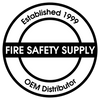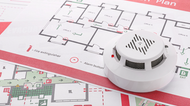The Importance of Smoke and Carbon Monoxide Detectors
Posted by the FSS Team on Sep 9th 2024
At Fire Safety Supply, while we specialize in fire extinguishers and other safety equipment, we frequently receive questions about smoke and carbon monoxide detectors. Although we do not sell these detectors, we understand how crucial they are for comprehensive fire safety. That's why we've compiled this information to help our clients make informed decisions about selecting, installing, and maintaining these life-saving devices. Ensuring you have the right knowledge is just as important as having the right equipment.
Smoke and carbon monoxide detectors are essential components of any comprehensive fire safety strategy. These devices serve as early warning systems that can save lives by detecting the presence of smoke, fire, or deadly carbon monoxide gas before they reach dangerous levels. By alerting occupants early, detectors provide crucial time to evacuate, call for help, and mitigate the spread of fire or exposure to harmful gases. In both residential and commercial settings, the importance of installing and maintaining these detectors cannot be overstated.
Types of Detectors
Understanding the different types of smoke and carbon monoxide detectors is vital for ensuring the right protection in your environment. Each type of detector has unique features designed to respond to specific conditions:
- Ionization Smoke Detectors: These detectors are particularly effective at detecting fast-burning fires, which produce small smoke particles. They work by ionizing the air within the device, causing a small, continuous current to flow between two plates. When smoke enters the chamber, it disrupts this current, triggering the alarm. Ionization detectors are ideal for areas where rapid-response detection is crucial, such as kitchens or near electrical appliances.
- Photoelectric Smoke Detectors: Photoelectric detectors excel at sensing smoldering fires, which produce larger smoke particles and are more common in the early stages of a fire. These detectors use a light source aimed at a sensing chamber. When smoke enters the chamber, it scatters the light, which is then detected by a sensor, setting off the alarm. These detectors are well-suited for bedrooms, living areas, and hallways where smoldering fires may occur.
- Dual-Sensor Smoke Detectors: Combining both ionization and photoelectric technologies, dual-sensor smoke detectors provide comprehensive coverage by detecting both fast-burning and smoldering fires. These are often recommended for maximum safety in residential and commercial buildings, ensuring that all types of fires are detected promptly.
- Carbon Monoxide Detectors: Unlike smoke detectors, carbon monoxide (CO) detectors identify the presence of carbon monoxide—a colorless, odorless, and deadly gas produced by incomplete combustion. These detectors monitor CO levels in the air and sound an alarm when dangerous concentrations are detected. CO detectors are essential in areas with fuel-burning appliances, such as kitchens, garages, and areas with fireplaces.
Installation Tips
Proper installation of smoke and carbon monoxide detectors is key to ensuring their effectiveness. Here are some best practices to follow:
- Smoke Detectors:
- Install smoke detectors on every level of your home or building, including basements and attics.
- Place detectors inside each bedroom and outside sleeping areas to ensure early detection during sleep.
- Avoid installing smoke detectors near windows, doors, or air vents, where drafts could interfere with their operation.
- In kitchens, install the detector at least 10 feet away from cooking appliances to reduce false alarms.
- Carbon Monoxide Detectors:
- Install CO detectors on every level of your home or building, particularly near sleeping areas and in rooms with fuel-burning appliances.
- Place detectors at knee height (since CO is slightly lighter than air) for the most accurate readings.
- Avoid installing CO detectors near windows, doors, or ventilation ducts where fresh air could dilute the carbon monoxide levels, delaying the alarm.
Maintenance and Testing
Regular maintenance and testing of your smoke and carbon monoxide detectors are crucial to ensuring they function correctly when needed most. Here are some tips:
- Testing: Test all detectors at least once a month by pressing the test button to ensure the alarm sounds. If the detector fails to respond, replace the batteries or the unit itself if it's non-functional.
- Battery Replacement: Replace the batteries in your detectors at least once a year, or whenever the low-battery warning chirps. Consider using long-life lithium batteries or opt for models with sealed, 10-year batteries to minimize maintenance.
- Cleaning: Dust and debris can interfere with the sensors in smoke and CO detectors. Clean the detectors regularly with a vacuum cleaner or a soft brush attachment to keep them free of contaminants.
- Replacement: Smoke detectors should be replaced every 10 years, while CO detectors typically last between 5 to 7 years. Check the manufacturer’s recommendations for your specific model.
Smoke and carbon monoxide detectors are critical life-saving devices that provide early warnings of fires and CO exposure, allowing for timely evacuations and emergency response. By understanding the different types of detectors, following proper installation guidelines, and committing to regular maintenance and testing, you can ensure these devices operate effectively and provide the protection you and your occupants need. Investing in reliable detectors and keeping them in good working order is one of the most straightforward and impactful steps you can take toward safeguarding lives and property.
As mentioned, we do not sell Smoke or Carbon Monoxide detectors but we do sell lots of other high quality well priced fire safety supplies such as fire extinguishers, fire suppression systems, and more.
 Since 1999, Fire Safety Supply has been the go-to for fire suppression products, industrial dry chemical systems, high and low-pressure CO2, vehicles, and clean agents. We serve various types of industries such as restaurants, commercial kitchen, wineries, and more.
Since 1999, Fire Safety Supply has been the go-to for fire suppression products, industrial dry chemical systems, high and low-pressure CO2, vehicles, and clean agents. We serve various types of industries such as restaurants, commercial kitchen, wineries, and more.
